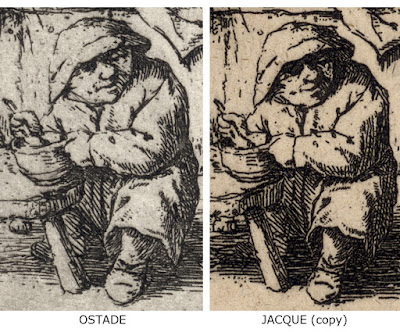Aegidius Sadeler II (aka Gillis Sadeler; Egidius Sadeler;
Ægedius Sadeler) (c1570–1629)
"Forest
Landscape with Two Figures” (TIB title), 1597–1629, plate 4 in the series of 8
plates, “Bohemian landscapes”, published by Aegidius Sadeler II and Marco Sadeler
(as inscribed on the plate), after a drawing by Pieter Stevens II (c1567–1624) in the Museum Boymans-van Beuningen,
Rotterdam.
Etching and
engraving on fine laid paper trimmed along the platemark.
Size: (sheet
trimmed unevenly) 16.7 x 29.7 cm
Lettered on the
plate below the image borderline: (left) “P Stephani Inuent: / Egi: Sadeler
excud:”; (right) “Marco Sadeler excudit.”
State ii (of iv)
TIB 1997 7201.275
S2 (vol. 72, Part 2, Supplement, p. 79); Hollstein 1980, vol. 21, no. 266; Prag
um 1600, no. 272; Piccin, no. 98
The Rijksmuseum
offers the following description of this print:
“A forest
landscape. On the road travellers. In the background an inn where hikers rest.”
Condition: richly inked, crisp and well-printed
impression trimmed on or within the platemark. The sheet is in excellent
condition (i.e. there are no tears, holes, folds, abrasions, stains or foxing).
There are remnants of mounting (verso).
I am selling
this exceptionally rare print—so rare that it is not in the collection of the
British Museum—by one of the great master printmakers of the late Renaissance
for the total cost of AU$337 (currently US$255.03/EUR215.30/GBP189.59 at the
time of this listing) including postage and handling to anywhere in the world.
If you are
interested in purchasing this museum quality impression sparkling with strong
tonal contrasts, please contact me (oz_jim@printsandprinciples.com) and I will
send you a PayPal invoice to make the payment easy.
This print has been sold
Interestingly,
Isabelle de Ramaix (1998) in “The Illustrated Bartsch”, vol. 72, Part 2,
Supplement, p. 79, advises that “Zwollo attributes the engraving to Isaac
Major” (see, AN Zwollo 1968, “Pieter Stevens, ein vergessener Maler des
Rudolfȉnische Kreises” in “Jahrbuch der Kunsthistorischen Sammlungen in Wien,
n.s., 64, p. 158).
Although both august
writers would have a much better understanding of the historical details underpinning
the execution of this print, nevertheless, based solely on the publication details inscribed
on the plate in state iii, I doubt that Isaac Major could be the printmaker who etched and engraved this plate. The reason is simply that in state iii
(after the erasure of the publication details shown on this state ii
impression) the lettered publication details state clearly: “Gravé par Sadeler” (i.e. the plate was engraved by
Sadeler—presumably by Aegidius Sadeler).























































